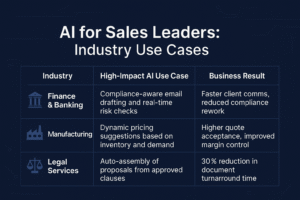Growth targets have not relaxed, but customer decision cycles clearly have. In finance, banking, manufacturing, and legal, boards expect predictable revenue while budgets tighten. To reconcile the two, many C-suits are treating AI for sales not as experimental technology but as a practical lever—one that improves forecast reliability, frees seller capacity, and protects margin.
The New Reality of Selling in a Downturn
- Pipeline health is harder to predict. Sparse CRM updates and elongated approvals limit visibility.
- The cost of sale is under review. CFOs want leaner operations; CIOs must rationalize overlapping tools.
- Manager bandwidth is finite. Manual pipeline reviews and follow-ups consume time better spent on coaching.
These conditions widen the gap between organization’s that embed intelligence in daily workflows and those that rely on manual effort.
How AI Helps Sales Teams Win
-
Forecasting with Confidence
Machine-learning models evaluate historical win rates, buying-group activity, and deal velocity to surface risk early enabling finance and sales leaders to adjust territory coverage or spending before quarter-end.
-
Boosting Rep Productivity
Automated call summaries, email drafts, and CRM updates reduce administrative load. In pilots across several global banks, reps recovered 5–7 hours per week—time redirected to client meetings.
-
Smart Nudges and Deal Coaching
AI monitors inactive thresholds (e.g., no stakeholder response after seven days) and recommends the next steps. Managers receive concise alerts instead of combing through dashboards.
-
End-to-End Process Automation
Document generation, quote approvals, and renewal reminders now run on predefined rules, cutting average cycle time for complex manufacturing proposals by 18 %.

What the Numbers Say
Enterprises deploying enterprise AI sales capabilities report:
- 20–30 % greater forecast accuracy
- 15–25 % shorter deal cycles
- 2× increase in seller time spent on client engagement versus admin tasks
External benchmarks (McKinsey, 2024) show 15 % higher lead-to-close conversion when AI guides outreach sequencing.
What Enterprise Leaders Can Do Now
- Map friction points. Quantify hours spent on manual updates, reviews, and approvals.
- Priorities low-disruption pilots. Start with call summarization or risk scoring—projects that integrate with existing CRM data.
- Select vertically aware partners. Ensure providers understand regulatory requirements and can scale securely across regions.
Early wins build confidence and fund broader initiatives.
Boosting Revenue with Intelligent Sales Agents
Download our free AI sales assistant playbook to increase B2B revenue and see how targeted nudges can shorten cycles and lift win rates.
Final Thoughts
Periods of slower growth expose operational inefficiencies. Organizations that embed AI services for sales leaders turn those gaps into gains—achieving precision forecasts, faster cycles, and disciplined cost control without adding headcount.


